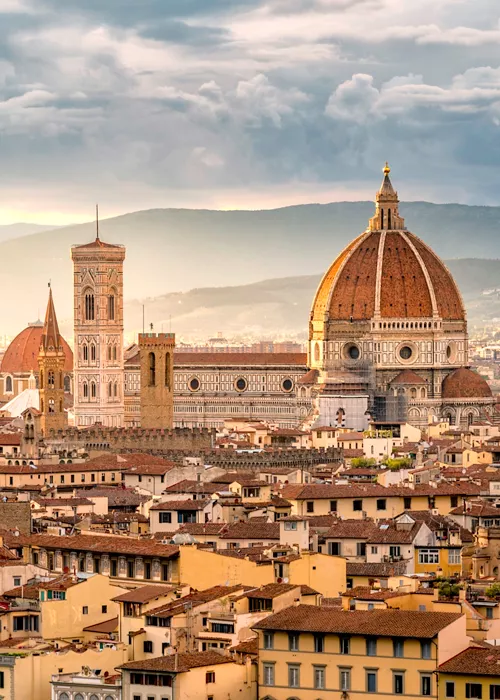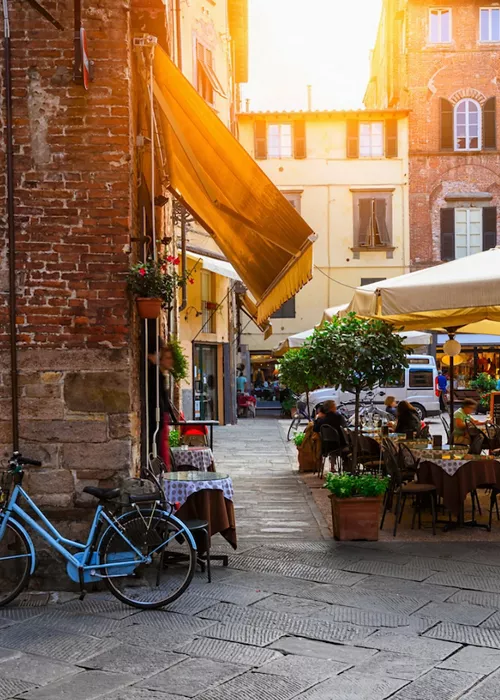Prato, where art is all around you
6 minutes

A visit to Prato is a feast for the eyes, a chance to discover the city and let our minds and hands experience a wonderful, unending stream of sensations. We start our journey in Tuscany right here, in this city where every place becomes a thought and every thought becomes art, a city where every monument to the past bears witness to a history of resourcefulness and pride.
Let us be guided by Curzio Malaparte's observation as we discover that "it is in Prato where everything ends: the glory, the honour, the piety, the pride, the vanity of the world".
On the trail of Curzio Malaparte

"I am from Prato; if I had not been born in Prato, I would not have wanted to be born, and I think that Tuscans' only fault is that they are not all from Prato". The words of Curzio Malaparte, born Kurt Erich Suckert, driven by the pride of a true Prato local.
For him, Prato was not just a birthplace: it followed and inspired him his whole life and is where he now rests after his death.
Malaparte is therefore the best travel companion to reach Prato, to visit it and discover its inner soul under the guidance of a man who, despite being from the city, always saw it through the amazed eyes of a tourist.
Prato is too often remembered only for its factories and the industrious activity of its Chinese community or for the centuries-old tradition of the lanaioli (wool workers). As Malaparte takes us by the hand, we go beyond this and get to know Prato, discovering priceless images that warp space and distort all our preconceptions. Walking alongside this unusual and courageous writer means seeking the values of pure art and defending them from a society based on consumption – including tourism. It means discovering the true face and history of the city which, a bit like Malaparte himself, has managed to strike the balance between power and freedom, between the suffering of being on the margins and the pride of reclaiming this difference.
The Prato writer and his haunts

Prato is like a performance that changes around those who visit it. Its architecture seems to dance, with the stonework of the city centre and the local materials revealing a unique and wild yet delicate nature unlike practically any other in Tuscany. Following Malaparte on the journey to his mausoleum, we can discover this sharp and spellbinding soul formed of wind and rock.
Curzio Malaparte died in Rome on 19 July 1957 but, at his request, his body was placed in a magnificent stone tomb at the top of the mountain that the inhabitants of Prato call Spazzavento, at the start of the Bisenzio valley, on the plain where Florence and Pistoia lie. From here, the view ranges from the heights of the Calvana Mountains, where we find Prato, to the hills of Monteferrato, covered with woods and cultivated fields. Here, you can enjoy relaxing strolls or hikes in a mountainous environment where the dense vegetation leaves room for the karst phenomena typical of the area.
Returning to the centre, the ancient heart of Prato tells a magnificent tale of the history of the land: the more than 70 towers, with their vertical perspectives and austere facades interrupted only by small windows, narrow porticoes, arrow slits and putlog holes, have dominated and defended the city with their bold, gruff demeanour since as long ago as the 12th century.
Between the Renaissance and modernity

The austere profiles of these buildings evoke the city's medieval sights and ambience, as well as the history and exploits of Francesco di Marco Datini, another symbol of Prato's enterprising spirit. He invented the bill of exchange, the at sign (@) as a communication symbol, and a new concept of thoroughly modern business: his business skills combined with his outstanding qualities as a benefactor made him an extraordinary example of a merchant in the early Renaissance period.
Renaissance and contemporary art

The historic centre is also notable for the presence of the only example of Swabian architecture in central-northern Italy, the Emperor's Castle.
In the centre of Piazza del Duomo stands the Fontana del Pescatorello (Fountain of the Little Fisherman), which Malaparte describes as "the pink stain of the marble fountain, with the beautiful colour of flesh".
The pulpit designed by Donatello and Michelozzo stands proud of the facade of the cathedral, which marvellously encapsulates the art and history of the city. Its interior, where the venerated relic of the Holy Belt of the Madonna is preserved, is decorated with splendid frescoes by Filippo Lippi, known as the "friar with offspring": initially excommunicated for the relationship that led to him having a son, he was then rehabilitated thanks to the intervention of Cosimo De' Medici.
Who was born in Prato?

In this square, which captivated Hermann Hesse among others, Malaparte stopped to enjoy those carefree moments that allowed him to face his many enemies: he only needed a few friends to not feel alone or to enjoy a nice cup of coffee sitting at a table with other local artists. Once again distinguishing itself from the classic image that we have of Tuscany, Prato maintained a vibrant cultural dynamism throughout the 20th century. This attracted prominent painters such as Ardengo Soffici, the founder of the "School of Prato" in the 1930s, but also edgy and rebellious writers and performers such as brothers Sandro and Giovanni Veronesi, Roberto Benigni, and Francesco Nuti: people capable of exciting and entertaining us, shaped by an environment steeped in the sense of humour shared by the city's bars, taverns and clubs.
A hotbed of contemporary art

Prato is like an open-air art studio that straddles the avant-garde and pop culture. Here, creativity is driven by a passion for contemporary art and shaped by the same industrial zeal that characterises the area. Prato continues to engage in a fruitful dialogue with contemporary genius: the Buco di Prato, a monumental creation in white marble by Henry Moore, is one of the finest examples of contemporary sculpture in Italy. This ongoing, devoted relationship with the avant-garde is illustrated by numerous events that continue to enrich the city with major artistic statements such as the light and shadow installation by Fabrizio Corneli known as Grande Sognatrice and the Luigi Pecci Centre for Contemporary Art.
Prato's textile tradition and cuisine

The thing that makes Prato a unique city is that here you can touch beauty, rather than just look at it. Unlike other areas of Tuscany or Italy, the physicality of Prato's textile-making tradition has influenced its society and its relationship with masterpieces, which are shot through here with tangible industriousness and craft.
The aroma of its biscotti, also commonly known as cantucci, brings richness to the city's genuine cuisine, with specialities including Bozza di Prato (a traditional bread), Prato mortadella, and sedano alla pratese, a stuffed celery dish. It's all accompanied by the excellent flavours of high-quality alcoholic nectars like Carmignano, the world's first ever CDO wine thanks to an announcement issued by Cosimo de' Medici, or the centuries-old Vermouth di Prato.
Being "Pratese" is therefore a way of living that combines a proud and indomitable spirit with a supreme impulse to seek out freedom of action, thought and feeling. An eternal love, exhilarating yet poignant at the same time; something to cherish, once you leave Prato, as a hidden treasure that will accompany you on your journey in search of the best Italy.

























